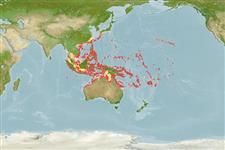| Native range | All suitable habitat | Year 2100 |

|
| Amphiprion perideraion AquaMaps Data sources: GBIF OBIS |
Length at first maturity
Lm ?, range 6 - ? cm
Human uses
Fisheries: of no interest; aquarium: commercial
Phylogenetic diversity index
(Ref. 82805)
PD50 = 0.5000 many relatives (e.g. carps) 0.5 - 2.0 few relatives (e.g. lungfishes)
Trophic Level
(Ref. 69278)
2.2 ±0.0 se; Based on diet studies.
Resilience
(Ref. 69278)
Medium, minimum population doubling time 1.4 - 4.4 years (K=0.48; tm=1.75-1.83; annual Fec=2,000-4,000)